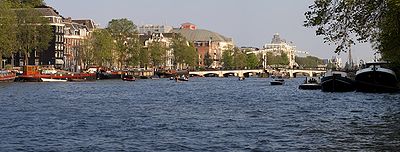
Magere Brug
Encyclopedia


Amstel
The Amstel is a river in the Netherlands which runs through the city of Amsterdam. The river's name is derived from Aeme stelle, old Dutch for "area abounding with water"....
in the city centre of Amsterdam
Amsterdam
Amsterdam is the largest city and the capital of the Netherlands. The current position of Amsterdam as capital city of the Kingdom of the Netherlands is governed by the constitution of August 24, 1815 and its successors. Amsterdam has a population of 783,364 within city limits, an urban population...
. It connects the banks of the river at Kerkstraat (Church Street), between Keizersgracht (Emperors' Canal) and Prinsengracht (Princes' Canal).
The central section of the Magere Brug is a bascule bridge
Bascule bridge
A bascule bridge is a moveable bridge with a counterweight that continuously balances the span, or "leaf," throughout the entire upward swing in providing clearance for boat traffic....
made of white-painted wood. The present bridge was built in 1934. The first bridge at this site was built in 1691 as Kerkstraatbrug and had 13 arches. Because this bridge was very narrow, the locals called it magere brug, which literally means "skinny bridge". In 1871 the state of the bridge was so bad that it was demolished and replaced by a nine-arched wooden bridge. Fifty years later this bridge also needed to be replaced. Architect Piet Kramer
Piet Kramer
Pieter Lodewijk Kramer was a Dutch architect, one of the most important architects of the Amsterdam School ....
made several designs for a steel and stone bridge, but the city decided to replace it with a new bridge that looked the same as the previous, only slightly bigger. In 1934 the bridge was demolished and replaced. The last major renovation was in 1969. Until 1994 the bridge was opened by hand, but now is opened automatically.
Use of the bridge has been limited to pedestrians and cyclists since 2003. It is however opened many times a day in order to let through river traffic. The boats used for sightseeing tours are low enough to pass underneath the bridge when closed. The bridge is decorated with 1200 light bulbs that are turned on in the evening.
A story told to tourists about the origins of the 1691 version of the bridge is that it was built by two wealthy sisters who lived on opposite sides of the Amstel river and wanted to be able to visit one another every day (and were presumably too busy, or not in good enough health, to go the long way round via another bridge, of which there must surely have been at least one). In one variant of the story the sisters, although wealthy, were not quite wealthy enough to afford a bridge of adequate width for general use and so built a very narrow bridge, hence its name. In another variant of the story the sisters' last name was Mager, hence the bridge's name (rather than from its narrowness).
The bridge can be seen in a number of films, such as the James Bond film Diamonds Are Forever
Diamonds Are Forever (film)
Diamonds Are Forever is the seventh spy film in the Eon Productions James Bond series, and the sixth and final Eon Productions film to star Sean Connery as the fictional MI6 agent James Bond. The film is based on Ian Fleming's 1956 novel of the same name, and is the second of four James Bond films...
from 1971.

